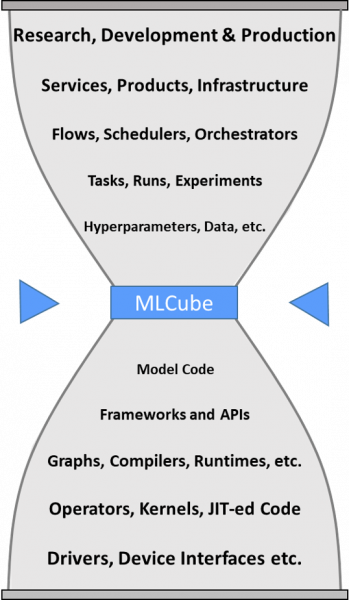Since the launch of MLCommons, Red Hat has been an active participant in the MLCube project hosted by the Best Practices Working Group. Red Hat employees are contributing to the design and development of this exciting project which aims to reduce friction around creating and consuming machine learning (ML) models.
 MLCube is designed to make it easier for researchers to share innovative ML models, developers to experiment with different models, and software companies to create infrastructure for models. MLCube provides a thin interface for creating "plug and play" ML models that can be shared across the artificial intelligence (AI) industry and acts as a shipping container for these models.
MLCube is designed to make it easier for researchers to share innovative ML models, developers to experiment with different models, and software companies to create infrastructure for models. MLCube provides a thin interface for creating "plug and play" ML models that can be shared across the artificial intelligence (AI) industry and acts as a shipping container for these models.
MLCube aims to address several key issues. Let's look at some of the most pressing issues we would like to solve.
Integrating ML models wastes time and slows deployments to production
When using a model you didn't author yourself, you need to do substantial manual work to enable the model to run on a new system. This slows down R&D and hinders the user experience for AI platforms. MLCube offers a standard mechanism for packaging models in a standard way to avoid this manual work.
Non-standard interfaces and custom configurations hinder broad adoption of ML
MLCube helps enable “plug and play” models with a simple, clean and thin interface. It is presented as a directory that contains:
-
An OCI-compliant container image (e.g., a Podman image)
-
The metadata to run the image
-
The metadata for one or more supported ML tasks
Today, the ML tasks are essentially file system-level function calls. The work is ongoing to extend this concept to work with inferencing (model serving). Here is an example of MLCube executing a training task:

No standardized way of packaging ML models
Model creators use unique and disparate methods for packaging their models with custom scripts and configuration settings. Due to lack of standardization of model packaging many hours are spent simply trying to get models run on a new system.
MLCube provides a way to create and specify the information needed to run the model. An MLCube can be constructed by any model creator who follows a simple checklist for packaging the model into a shareable container with the standardized interface common to all MLCubes. MLCommons provides tools to help validate and run these packages.
Difficulties in sharing models at both the training and inference steps of the model lifecycle
MLCube is not a siloed solution, it is designed as an ecosystem enabler that helps remove friction and share models broadly. MLCubes can be used for training or inference across multiple platforms: Linux, Kubernetes, and public clouds.
The Best Practices Working Group provides reference runners - simple software to help with executing MLCubes, but it also encourages third parties to adopt MLCube for use with more powerful infrastructure.
Red Hat is working with a number of MLCommons members to further develop the MLCube concept. Specifically, we rely on Podman and Red Hat Universal Base Image (UBI) as foundational OCI-compliant components that are used to create an MLCube.
Podman is designed to run, build, share and deploy applications using OCI container images. A great advantage of Podman vs. other container runtimes, such as Docker, is it does not require root privileges to run containers, making it a safer and less error-prone tool.
UBI is based on Red Hat Enterprise Linux (RHEL) and allows you to build, share and collaborate on your containerized application where you want. Model creators can choose to use freely distributable UBI as the base layer of their OCI containers and use Podman to run them, making these enterprise-grade software technologies available to the users of their MLCubes.
Red Hat has a history of contributing and shaping open source solutions that benefit the entire industry. Through our involvement in the best practices working group in general, and in the development of the MLCube concept in particular, Red Hat is aiming to provide a complete and effective solution that could greatly improve the adoption of many ML applications.
Stay tuned for future updates on the progress MLCommons is making in democratizing access to AI and machine learning for everyone.
About the authors
Diane Feddema is a Principal Software Engineer at Red Hat leading performance analysis and visualization for the Red Hat OpenShift Data Science (RHODS) managed service. She is also a working group chair for the MLCommons Best Practices working group and the CNCF SIG Runtimes working group.
She also creates experiments comparing different types of infrastructure and software frameworks to validate reference architectures for machine learning workloads using MLPerf™. Previously, Feddema was a performance engineer at the National Center for Atmospheric Research, NCAR, working on optimizations and tuning of parallel global climate models. She also worked at SGI and Cray on performance and compilers.
She has a bachelor's in Computer Science from the University of Iowa and master's in Computer Science from the University of Colorado.
Yan Fisher is a Global evangelist at Red Hat where he extends his expertise in enterprise computing to emerging areas that Red Hat is exploring.
Fisher has a deep background in systems design and architecture. He has spent the past 20 years of his career working in the computer and telecommunication industries where he tackled as diverse areas as sales and operations to systems performance and benchmarking.
Having an eye for innovative approaches, Fisher is closely tracking partners' emerging technology strategies as well as customer perspectives on several nascent topics such as performance-sensitive workloads and accelerators, hardware innovation and alternative architectures, and, exascale and edge computing.
Browse by channel
Automation
The latest on IT automation that spans tech, teams, and environments
Artificial intelligence
Explore the platforms and partners building a faster path for AI
Open hybrid cloud
Explore how we build a more flexible future with hybrid cloud
Security
Explore how we reduce risks across environments and technologies
Edge computing
Updates on the solutions that simplify infrastructure at the edge
Infrastructure
Stay up to date on the world’s leading enterprise Linux platform
Applications
The latest on our solutions to the toughest application challenges
Original shows
Entertaining stories from the makers and leaders in enterprise tech
Products
- Red Hat Enterprise Linux
- Red Hat OpenShift
- Red Hat Ansible Automation Platform
- Cloud services
- See all products
Tools
- Training and certification
- My account
- Developer resources
- Customer support
- Red Hat value calculator
- Red Hat Ecosystem Catalog
- Find a partner
Try, buy, & sell
Communicate
About Red Hat
We’re the world’s leading provider of enterprise open source solutions—including Linux, cloud, container, and Kubernetes. We deliver hardened solutions that make it easier for enterprises to work across platforms and environments, from the core datacenter to the network edge.
Select a language
Red Hat legal and privacy links
- About Red Hat
- Jobs
- Events
- Locations
- Contact Red Hat
- Red Hat Blog
- Diversity, equity, and inclusion
- Cool Stuff Store
- Red Hat Summit


